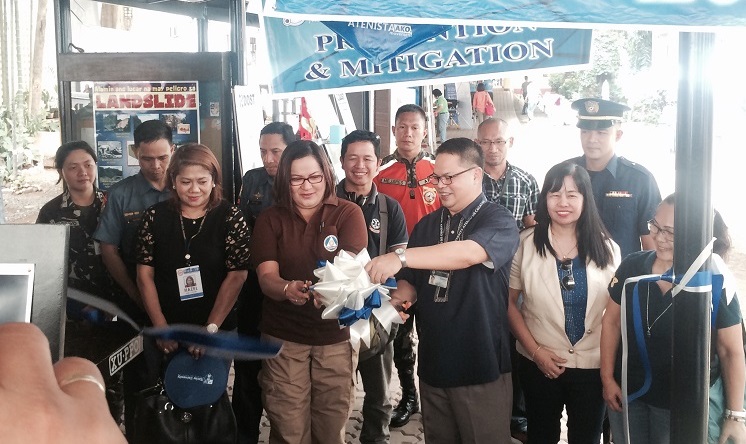
DRRM EXHIBIT. Office of Civil Defense - Region X director Ana C Cañeda and XU academic vice-president Fr Rene C Tacastacas SJ lead the ribbon-cutting ceremony of the static exhibit of Disaster Risk Reduction and Management (DRRM)-related information materials, programs, and equipment on July 1 at Xavier's Magis Walkway.
Given that the Philippines is lashed by some 20 strong storms per year, the observance of the National Disaster Consciousness Month puts the spotlight on instilling disaster preparedness not merely the government's duty but as everybody’s responsibility.
Anchored on the theme, “Kahandaan at pagtugon sa sakuna, tungkulin ng bawat isa (Readiness and response to crisis, everybody's duty),” various stakeholders took part in the kick-off activity of the NDCM on July 1 at Xavier University in Cagayan de Oro City.
Office of Civil Defense - Region X director Ana C Cañeda and XU academic vice-president Fr Rene C Tacastacas SJ frontlined the ribbon-cutting ceremony of the static exhibit of Disaster Risk Reduction and Management (DRRM)-related information materials, programs, and equipment from various government agencies.
“[Disaster preparedness] is not just government’s effort, but the whole nation’s responsibility,” Cañeda said in her message. “All of us must work together proactively, from the community down to the household level.”
She added that with the new administration, under President Rodrigo Duterte, OCD is mandated to strengthen its programs to underscore the importance of climate change adaptation and DRRM initiatives, particularly in vulnerable barangays.
Under Republic Act 10121 or the Philippine Disaster Risk Reduction and Management Act of 2010, local government units, particularly the barangays must take the lead in disaster risk reduction, as well as disaster management and response.
Bearing “#ResiliencePH,” the said exhibit was divided into four parts: mitigation, preparedness, response, and rehabilitation, which reflect the “comprehensive DRRM plan” of the government. Blood-letting activities also formed part of the July 1 event at XU.
Tacastacas also drummed the role of academic institutions in the region to complement public programs by keeping the community informed on why DRRM is an individual and community responsibility, and teaching the youth to be involved in disaster planning.
Besides XU’s relief operation, Oplan Tabang Sendong in December 2011, Xavier, the local government and different partners established Xavier Ecoville as the resettlement village for the victims of TS Sendong (Washi), which rendered thousands of families homeless. Today, Ecoville stands as a testament to the resiliency of the families who survived the calamity.
XU is also an active member of the Regional Disaster Risk Reduction and Management Council (RDRRMC) through its Engineering Resource Center, which serves as a think-tank in Northern Mindanao on the science of disaster and climate change.
Held every July, NDCM activities, namely, information education communication (IEC) exhibits, disaster planning workshops, and community drills are part of the precautionary measures as the country enters the typhoon season.
The mandated observance aims to bolster the awareness of Filipinos on natural and man-made disasters.
On his first day at work, newly appointed NDRRMC executive director Undersecretary Ricardo Jalad called on all sectors to unite to build resiliency throughout the country.
“This year’s theme, “Kahandaan at pagtugon sa sakuna, tungkulin ng bawat Isa,” highlights the core intention of this annual observance: To make our people own DRRM as a personal responsibility; that surviving, outlasting the ravages of any hazard, and making communities resilient, is a duty of every Filipino,” Jalad told reporters in Manila. ∎